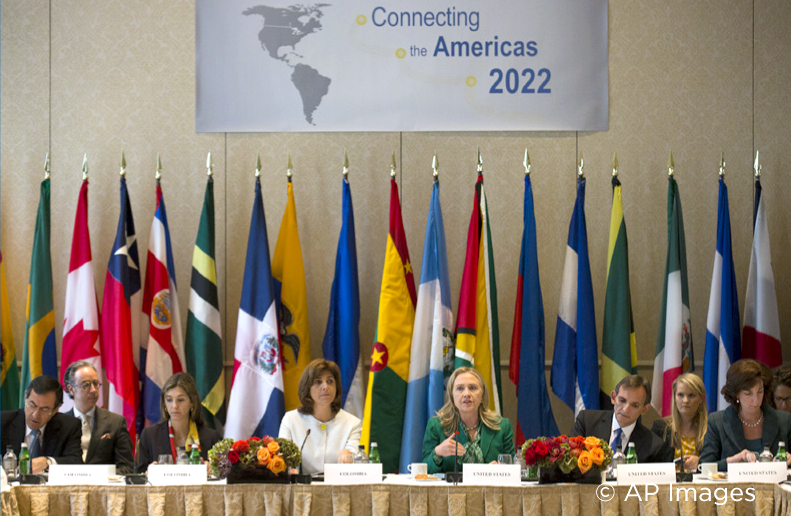By Barry Cassell, TransmissionHub.com
October 19, 2012
The Obama Administration, along with other countries in the Americas, is working toward the concept of an integrated electricity grid that stretches from northern Canada to the southern tip of South America.
Secretary
of State Hillary Rodham Clinton, in a major energy address Oct. 18 at
Georgetown University in Washington, said: “Earlier this year, at the
Summit of the Americas, Colombia launched a new initiative it is
leading with the United States called Connecting the Americas 2022. 
It
aims to achieve universal access to electricity by the year 2022
through electrical interconnection in the hemisphere, linking
electrical grids throughout the hemisphere from Canada all the way down
to the southern tip of Chile, as well as extending it to the Caribbean.
The Inter-American Development Bank, the World Bank, all the countries
in the Organization of American States have joined this project. It
stems from a broader effort called the Energy and Climate Partnership of the Americas, which I launched in 2010, which has sparked a wave of innovative partnerships across the hemisphere.”
Clinton
said that interconnection will help get the most out of the resources
in this region. “It seems simple, but if one country has excess power,
it can sell it to a neighbor,” she said. “The climate variability
across our region means that if one country has a strong rainy season,
it can export hydropower to a neighbor in the middle of a drought.
Plus, by expanding the size of power markets, we can create economies
of scale, attract more private investment, lower capital costs, and
ultimately lower the costs for the consumer.”
Another goal has
to do with the fact that 31 million people across the Americas lack
access to reliable and affordable electricity. “That clearly holds them
back from making progress in so many areas,” Clinton noted. “So one aim
of Connect 2022 is to make sure that those 31 million people now do
have power. With this single project, we will promote energy efficiency
and renewable energy, fight poverty, create opportunity for energy
businesses, including U.S. businesses, and forge stronger ties of
partnership with our neighbors. It really is a win-win-win, in our
opinion.”
Every day, in many parts of the world, U.S. diplomats
are fighting on behalf of American businesses and workers, taking aim
at economic barriers and unfair practices related to energy, she said.
“This September, we achieved a major breakthrough when the members
nations of the Asia Pacific Economic Cooperation community agreed to
cut tariffs on 54 key environmental goods, clearing the way for more
trade in clean energy technology,” she added.
Clinton: Clean electricity gets people off dirty fuels
Because
1.3 billion people worldwide do not have access to a reliable,
sustainable supply of energy, they are burning firewood, coal, dung,
charcoal, whatever they can get their hands on. “They’re using diesel
generators, and no electricity is more expensive than that,” she said.
“And besides, these are dirty forms of energy – bad for people’s
health, bad for the environment. But it doesn’t have to be that way. We
have the technology and know-how that can help people leapfrog to
energy that is not only reliable and affordable, but clean and
efficient. So energy transformation and ending energy poverty really do
go hand in hand.”
Clinton noted that in the U.S., use of
renewable wind and solar power has doubled in the past four years. “Our
oil and natural gas production is surging,” she said. “New auto
standards will double how far we drive on a gallon of gas. And for the
first time, we’ve introduced fuel efficiency standards for heavy
trucks, vans, and buses, all of which will cut costs. That means we are
less reliant on imported energy, which strengthens our global political
and economic standing and the world’s energy marketplace.”
Clinton
added: “Oil markets are global and natural gas markets are moving in
that direction, many power grids span national boundaries. Even when
Americans are using oil produced entirely within the United States, the
price of that oil is largely determined by the global marketplace. So
protecting our own energy security calls for us to make progress at
home and abroad. And that requires American leadership.”
One
year ago, the State Department opened a new bureau called the Bureau of
Energy Resources, which is charged with leading thedepartment’s
diplomatic efforts on energy. And in the coming weeks, Clinton said she
will be sending policy guidance to every U.S. embassy worldwide,
instructing them to elevate their reporting on energy issues and pursue
more outreach to private sector energy partners.
“Now, make no
mistake: In the past, the State Department obviously conducted
energy-related diplomacy – sometimes a great deal of it when specific
crises arose," Clinton said. “But we did not have a team of experts
dedicated full-time to thinking creatively about how we can solve
challenges and seize opportunities. And now we do. That, in and of
itself, is a signal of a broader commitment by the United States to
lead in shaping the global energy future.”
TerraWatts.com Global Energy Network Institute